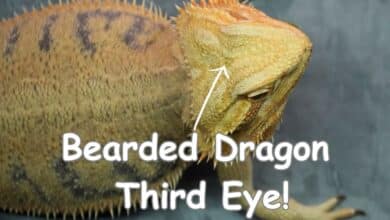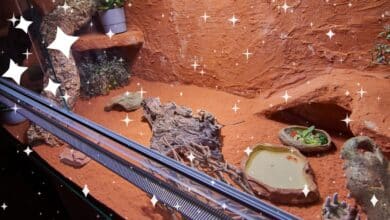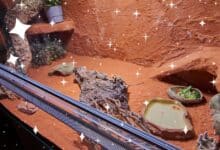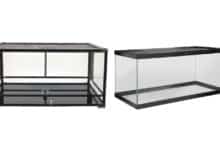Bearded Dragon Tank Size Guide to Prevent Health Problems

Bearded dragons are one of the most friendly lizards. They can live a long, healthy life in captivity with the right environment and care. The living environment for a bearded dragon is one of the most critical factors setting the baseline of its long-term health – with its tank being the most fundamental.
Providing the best tank size for bearded dragons to ensure we are giving them the best chance at living a happy, healthy life is something we can control and should take seriously for our little friends.
In this article, we will explore the following:
- Potential health issues that arise when the tank is too small
- How big of a tank does a bearded dragon need
- How to ensure the right tank size for a bearded dragon
Contents
Why Is Tank Size Important for Bearded Dragons?
Bearded dragons are active reptiles that need space to roam, bask, and explore. Appropriate tank size is essential to prevent health issues and behavioral problems from stunted growth to diseases.
A tank that is too small for a bearded dragon can lead to the following potential problems:
- Stunted Growth: Bearded dragons require space to move around and exercise, and if they live in a tank that is too small, they may not be able to move around as much as they need to. A small tank size can lead to stunted growth, which can result in various health problems down the road.
- Stress: Bearded dragons are social animals and require social interaction to thrive. Keeping bearded dragons in a small tank may cause them to become stressed and anxious, leading to various health problems.
- Aggression: Keeping bearded dragons in a tank that is too small can cause bearded dragons to become territorial and aggressive, leading to fights with other bearded dragons or potentially biting at their owners.
- Poor Hygiene: Bearded dragons require a clean and hygienic environment to stay healthy. As they grow, a bearded dragon’s tank will need more regular cleaning, and it can become more challenging to maintain good hygiene if it is too small.
- Lack of Appetite: Bearded dragons require a varied and nutritious diet to stay healthy. When bearded dragons live in small tanks, they may become bored with their food due to a lack of space to exercise and burn off calories. A lack of exercise can result in a lack of appetite and improper eating habits, causing malnutrition.
Selecting The Right Size Tank for a Bearded Dragon
Here are some of the critical factors to consider when selecting a bearded dragon’s tank size:
- Age and Size: The age and size of the bearded dragon are critical factors when selecting a tank size. A 20-gallon tank is generally suitable for a baby bearded dragon. Within a few months, the bearded dragon will need a larger tank – such as a 30-gallon tank. A 40-gallon breeder tank is the minimum recommended size for an adult bearded dragon. Larger tanks are always better.
- Enclosure Style: The type of enclosure also affects the tank size required. A glass or acrylic tank is the most popular option, but custom-built terrarium enclosures using PVC or other materials can also be options. Terrariums and fully-built bioactive bearded dragon vivarium tanks are becoming more popular. However, they can require more work for the inexperienced with having so many different living features inside the enclosure.
- Enclosure Features: Whichever type of enclosure you choose, ensure the dimensions are suitable for a bearded dragon. Height is less critical than floor area. You want to maximize their room to explore, hide, and have varied temperature areas. It would be best to have a screen lid to place lights on and to prevent the beardie from escaping.
- Activities: Bearded dragons are active reptiles that require ample space to move around, bask, and exercise. The tank size should provide enough room for the bearded dragon to move, climb, and explore.
- Multiple Bearded Dragons: If more than one bearded dragon lives in the same tank, a larger enclosure will be necessary to provide enough space for all the dragons to move around and establish their territories.
- Accessories: The accessories inside the enclosure can impact the space available for the bearded dragon for various activities. Items such as a heat lamp for a basking spot, UVB light for proper digestion, hide boxes for burrowing and sleeping, plants or other vegetation, and other accessories to make a similar natural habitat as they would have in Australia should be taken into account when selecting the tank size

What Size Tank Does a Bearded Dragon Need?
Bearded dragon tank sizes depend on several factors, including but not limited to their age, size, and activity level. Below are some general guidelines for selecting a bearded dragon tank size based on age and size.
Baby Bearded Dragons (0-3 months old)
A tank that is at least 20 gallons in size is great for baby bearded dragons. Twenty gallons provides enough space for the dragon to move around, explore, and bask in a suitable temperature gradient. To prevent wasting money upgrading the tank down the road, skip right to a 40-gallon or larger tank.
Juvenile Bearded Dragons (4-12 months old)
Although a 30-gallon tank would work for a juvenile bearded dragon, a 40-gallon tank is the best tank size to get it settled in as it grows into a mature adult. Keeping them in a tank that is less than 40 gallons as they hit one year old could begin to stunt their growth or cause other health issues. Also, changing their tank size too much can stress them out.
Adult Bearded Dragons (1 year or older)
For an adult bearded dragon, a 40-gallon is the minimum recommended size. However, a larger tank is always better.
The 40-gallon high-wall aquarium-style tank is an option sometimes used for adult bearded dragons. However, it can be more challenging to provide proper heat and lighting. Structural accessories for the bearded dragon to climb on help them get adequate UVB and have proper basking temperatures in this tank. The 40-gallon breeder tank is a better option for an adult bearded dragon.
It is important to note that these guidelines are just general recommendations, and the tank size may need to be adjusted based on the individual needs of your bearded dragon. If you have a particularly active or larger-sized bearded dragon, purchasing a bigger tank will provide enough space for them.
Bearded dragons grow throughout their entire lives. They may outgrow their enclosure, particularly if you need to upgrade their tank beyond a 30-gallon. Keep a close eye on your bearded dragon, as health issues may be due to its enclosure size.
What is the Ideal Size Tank for a Bearded Dragon?
A 40-gallon breeder reptile tank is the most commonly used tank for bearded dragons. This tank size provides room for adding sizable structural accessories and vegetation. With enough space and a little more budget, a 75-gallon tank or larger size would be ideal for an adult bearded dragon.
How Tall Should a Bearded Dragon Tank Be?
The height of a bearded dragon tank should be at least 16 inches to allow for adequate heating and lighting. A tank around 16 inches tall allows for more distance between the basking area and the heat source to prevent overheating. Tanks with more height also will enable the beardie to climb and exercise.
Tanks with more height than 16″ are not always the best option. Going with a very tall tank can make most of the tank too cold for the bearded dragon, make it difficult to regulate temperatures at night, or have limited ground area for the bearded dragon.
Bearded Dragon Tanks by Size: When to Use Which Gallon Tank?
With the general rules stated above and the health and behavioral issues bearded dragons can experience with too small of a tank, I wanted to go through the standard tanks people use for bearded dragons in more detail. This way, you can have specific information on the tank you are looking to buy or already have that you are looking to use.
10-Gallon Reptile Tank: Not Ideal For Long-Term Use

A 10-gallon tank is insufficient for a bearded dragon, even a baby one.
First, if you are building out a proper environment, it will quickly become cramped. This small tank also doesn’t allow separate basking and cool areas for the bearded dragon to move about throughout the day. Finally, as the bearded dragon grows inside this small tank, it will experience health and behavior complications, as previously mentioned.
We highly recommend upgrading from a 10-gallon tank as soon as possible if you must temporarily use a 10-gallon tank when first bringing the tiny one home.
20-Gallon Reptile Tank for Baby Bearded Dragons

A 20-gallon tank may be suitable for a baby bearded dragon as it provides enough space to move around, explore, and bask. A 20-gallon tank can also make it easier to maintain a suitable temperature gradient when you are just getting familiar with taking care of a bearded dragon.
As the bearded dragon reaches 4-6 months old, you will need to get a larger tank to provide enough space to prevent health issues from potentially developing.
30-Gallon Reptile Tank for Juvenile Bearded Dragons
A 30-gallon tank may be suitable for a young or small bearded dragon. Still, as the dragon grows, a larger tank will be necessary to provide enough space for them to move around and exhibit natural behaviors.
Bearded dragons are active reptiles that require ample space to move around, bask, and explore. The minimum recommended tank size for an adult bearded dragon is 40 gallons, with a larger enclosure preferable. A 30-gallon tank may be appropriate for a young or small bearded dragon, but it will likely need upgrading as the dragon grows.
40-Gallon: Minimum Size Tank for Adult Bearded Dragon
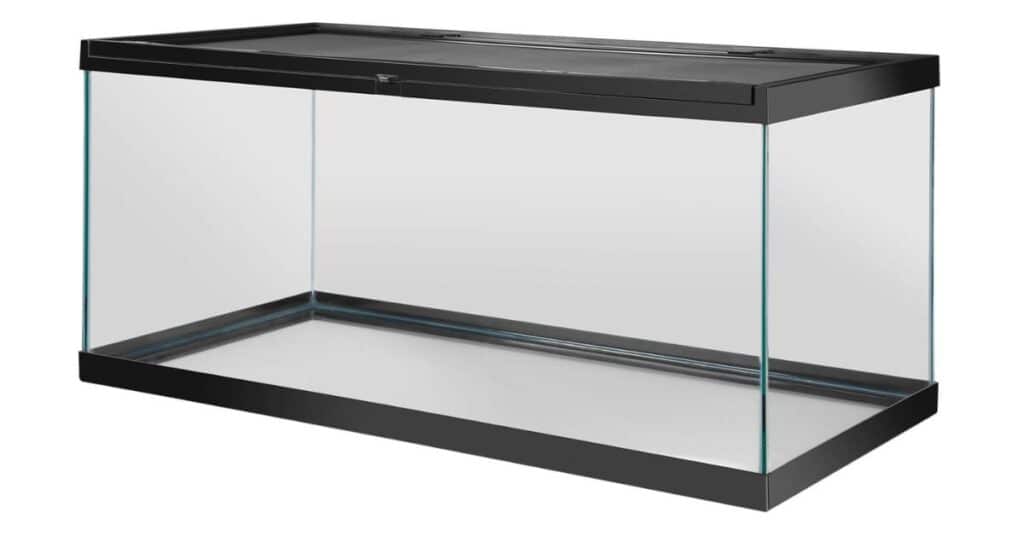
A significant difference exists between a 40-gallon aquarium tank and a 40-gallon reptile tank – the aquarium version will be taller with less floor area than the reptile or breeder tank.
The 40-gallon reptile tank is ideal for an adult bearded dragon. It helps maximize the floor area for them to run around for a similar price as the aquarium version. The reptile-style tank also allows the UVB and basking lamps to be closer to them without forcing them to sit on top of a tall structural accessory. A nice basking rock will do for the 40-gallon reptile tank.
A 40-gallon reptile tank, also known as a 40-gallon breeder tank, is the minimum recommended size for an adult bearded dragon over one year old. While larger tanks are always better, a 40-gallon tank allows room for accessories, creating specific areas for burrowing, sleeping, basking, shade, and vegetation.
Always ensure that the equipment and accessories do not overcrowd the tank. Tank size is a fundamental decision for not restricting the bearded dragon, but not getting too aggressive by adding an abundance of accessories is also something to keep in mind.
50-Gallon to 60-Gallon Tanks for an Adult Bearded Dragon
The 50-gallon, 55-gallon, and 60-gallon tanks are great options to provide one bearded dragon with plenty of room to get almost every aspect of its natural habitat included in its tank. The additional space allows for installing more structural items to get varied temperatures and adequate UVB.
Due to the added space, we recommend upgrading to these if you have the space, time, and resources to manage them.
75-Gallon & 100-Gallon Tanks for 1-2 Adult Beardies
For those who want to provide their bearded dragons with a bit more luxury, a 75-gallon tank is an excellent choice. This size tank is perfect for a bearded dragon with plenty of room to move around and play. It can also easily accommodate two bearded dragons. A 100-gallon tank is another option, suitable for a pair of bearded dragons.
120-Gallon Tank for 2 Adult Bearded Dragons
The largest commonly purchased tank for bearded dragons is the 120-gallon tank. The 120-gallon tank is an excellent choice for multiple bearded dragons that need plenty of space to roam. Keep in mind the potential risks of keeping multiple bearded dragons together in one tank, which include them becoming territorial and fighting or having a female bearded dragon become pregnant.


